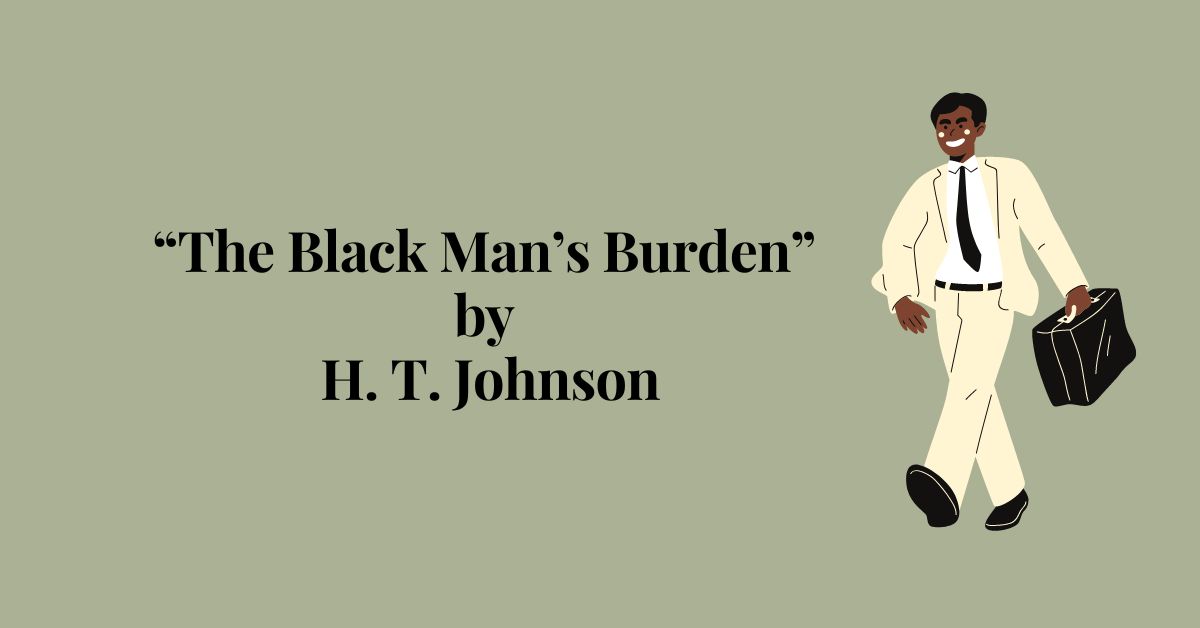Introduction
In 1899, a British novelist and poet, Rudyard Kipling, wrote a poem called “The White Man’s Burden,” in which Kipling encouraged the United States to take on the responsibilities of empire, similar to how Britain and other European nations had done so. In this poem, he addresses Theodore Roosevelt, who would later become vice-president and then president, and coins him as “good sense from the expansion point of view,” but not everyone shared this sentiment.
Although the poem raised apparent concerns, it received a mixed response from the readers. African Americans and many others strongly opposed the concept of the “white man’s burden.” Opposing Kipling’s idea, H. T. Johnson, a great African-American clergyman, and editor, came up with the contrastive poetic piece titled “The Black Man’s Burden.” Published in 1899, The poem highlights the similarities between the mistreatment of brown people in the Philippines and the mistreatment of black Americans in their own country.
Summary of “The Black Man’s Burden”
The poem presents a critique of imperialism and the subjugation of non-Western peoples by Western powers. The speaker encourages the reader to think about black people being oppressed and exploited. The speaker brilliantly highlights how powerful nations use their armies to conquer and control weaker peoples, fighting back with primitive weapons like clubs and arrows. The poem argues that it is wrong to try to solve this problem through violence and instead suggests that it should be addressed with honor and respect.
The speaker also touches on the ideas Kipling describes in his poem, “the White Man’s Burden,” to convey the idea that it was the moral duty of the Western nations to bring civilization and Christianity to the non-Western world, which was seen as inferior. Throughout the poem, the speaker suggests that black people are being burdened and oppressed by Western powers. Also, he highlights the irony that the white man’s burden would be a burden for the black man.
Thus, the poem implies that the imperialism of Western nations creates hurdles for those who are being colonized and oppressed. Moreover, it is also creating problems for the colonizers themselves, who are contributing to a cycle of violence and oppression. Ultimately, the poem argues that the only way to end this cycle is to change how we think about and treat other cultures and people.
Major Themes in the Poem
The poem’s central themes are violence, oppression, and misuse of power. The poem states that the burden of oppression and suffering is not only borne by people of color but is actively perpetuated by those in power. The poem’s speaker criticizes the actions of “fearless armies” who use violence to oppress and exploit people in other countries. Also, he reminds the reader that this same kind of oppression and exploitation exists in their own country, with the “Black Man’s Burden” being the closest to their own door.
Moreover, the speaker notes that attempts to end oppression using violence and force will ultimately be unsuccessful. He believes the only way to defend the oppressed is with honor and integrity. The poem also implies that only when the oppressors see and acknowledge the “burden” they are imposing will they take steps toward dismantling the systems that perpetuate that burden.
Finally, the poem highlights the interconnectedness of all forms of oppression, noting that oppression in Cuba and Hawaii is no different than oppression in the speaker’s own country and that all marginalized people must be united in their fight against oppression. The poem speaks to the idea that oppression is a global problem that affects people of all races and that working together is the only way to bring about real change.
Analysis of Literary Devices Used in the Poem
“Pile on the Black Man’s Burden” is a thought-provoking piece with various poetic elements to convey its central idea. The writer has inserted some poetic techniques to express his ideas, emotions, and thoughts. For example, the use of imagery is prominent throughout the poem, as the author uses vivid language to paint a picture of the plight of the black man. The line “Hail ye your fearless armies,/ Which menace feeble folks” paints a stark image of the powerful and imposing forces that oppress the black man.
The second poetic element he used is a strong sense of rhyme, as he implies a consistent pattern of rhyming words to create a sense of flow and continuity. This creates a sense of rhythm in the poem, making it more engaging and easy to read.
The use of metaphor is also evident in the poem, as the author uses the term “Black Man’s Burden” to symbolize the weight of oppression and discrimination that the black man bears. This metaphor highlights the heavy load that the black man carries and the struggle he faces.
Conclusion
In conclusion, “Pile on the Black Man’s Burden” is a powerful and thought-provoking poem that uses a variety of poetic elements to convey its message. The use of imagery, rhyme, and metaphor make this poem an effective and moving piece that highlights the plight of the black man and the need for change.
Suggested Readings

